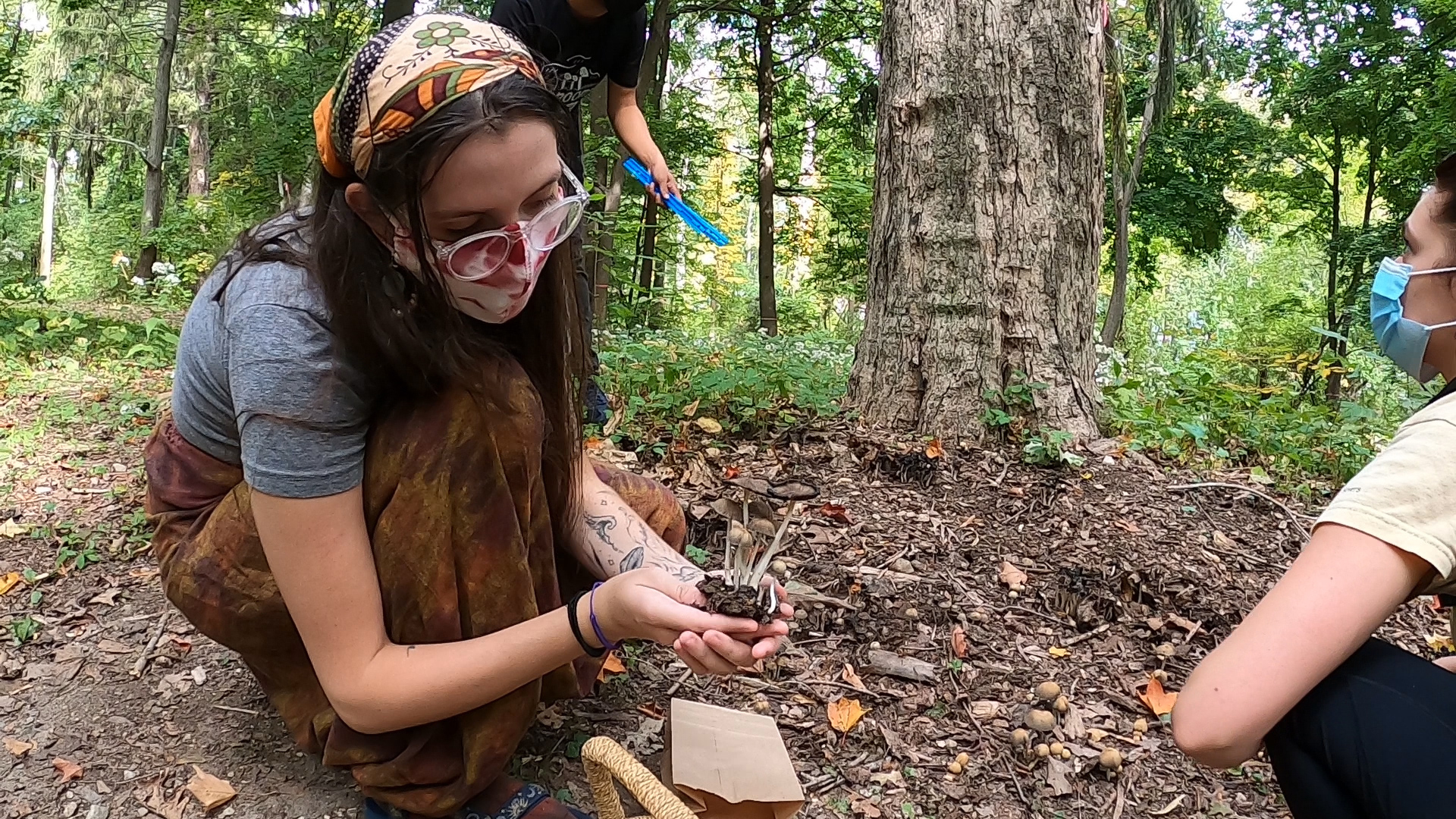Mycology students get hands-on in their forage for fungi

On the side of the Magnolia Trail in Clark University’s Hadwen Arboretum, Prasanth P. Prabhu waved his hands in the air, motioning for the rest of his group to come over. Prabhu, a Ph.D. student and teaching assistant in Professor David Hibbett’s Biology of Mushrooms course, had just made an exciting discovery — a large, fan-shaped fungus attached to a downed tree limb off the side of the trail.
After removing the mushroom with a jackknife and placing it into a basket, the class brought it back to a laboratory in the Lasry Center for Bioscience to identify it along with numerous other varieties collected during their outing. Over the next several weeks, the students will select several species to culture and cultivate in the lab — including edible mushrooms that they can take home and cook.
“This class is sampling lots of different areas, but it’s mainly about diversity of mushrooms, ecological roles, and ethnomycology, with a focus on mushroom-forming fungi,” Hibbett explains. “Fungi are the master recyclers of plant organic matter. They take all the carbon that’s locked up in wood and other plant tissues and release it back into the atmosphere as CO2, and also release nutrients that are trapped in plant material. They play a critical role in that regard.”
This semester, the introductory mycology class made several socially distanced trips to the nearby arboretum — a 15-minute walk from Clark’s campus — to forage for mushrooms. The University-owned property, located at the intersection of Lovell and May streets, contains 6.4 acres of woodland green space in the heart of Worcester. It is also home to thousands of varieties of fungi and hundreds of species of mushrooms, according to Hibbett, making it the perfect location for the students’ fieldwork.
Story continues after video
Despite poor growing conditions brought on by the summer’s severe drought, the class managed to locate about 20 varieties of mushrooms over the course of several outings — from edible species like the oyster mushroom to the highly toxic Amanita bisporigera, more commonly known as the “Destroying Angel” or “Angel of Death.”
“It’s been super dry lately, so we’re looking for anything we can find,” says Sofie Irons ’23. “What we’re finding mostly are species that grow in wood because they need slightly less water than mushrooms that grow in the ground.”
Irons, who plans to major in biology, decided to enroll in the course after taking a class with Hibbett last semester. She grew up hearing stories from her grandmother about foraging for mushrooms as a child and wanted to gain the knowledge to begin hunting for mushrooms herself. “If you’re going to be eating them, you need at least three different sources to confirm you have what you’re looking for,” she explains. “We’ll usually use different guidebooks to figure it out, and we also have a website we use.”
Hibbett says he’s seen an increasing number of students arrive at Clark with an interest in mycology. In addition to the growing popularity of foraging, people are also using fungi for artwork, packaging materials, and bioremediation, among other applications. Hibbett is currently serving on the Scientific Advisory Board of MycoWorks, a company that makes leather-like material out of fungal mycelium — the thread-like structures of fungi.
“Mushrooms are having this major cultural moment,” he says. “They’re just inherently cool organisms.”
In the lab, students use written resources and microscopes to identify the mushrooms’ genus and oftentimes their species. But it isn’t always easy. After collecting an assortment of fungi during a recent trip, Chris Aulbach ’21, an environmental science major, says he was able to correctly identify only three of seven species.
He explains that common mushrooms can usually be identified by the color of their spores, the color of their cap, and sometimes their texture. Once those “macro credentials” have been established, students examine the mushrooms under a microscope, examining the shape of their spores to determine a particular species. “It’s a lot of work,” Aulbach says. “It’s cool to figure out what you’re looking at.”
The class also began culturing fungi during the first week of the semester, taking tissue samples from chicken of the woods, shiitake, and oyster mushrooms and placing them in Petri plates to grow. If the samples are not contaminated, the students will take pieces of the agar — a gelatinous substance used as a culture medium for growing microorganisms — and cultivate them on rye grain or sawdust. From there, they can spawn new mushrooms.
“In one week, I had mushrooms I could bring home and add into a stir fry,” Aulbach says. “There’s something really cool about going into the woods and finding so many mushrooms I never would have seen had I not taken this class and known what to look for.”
Hibbett has been teaching at Clark for 20 years and is considered one of today’s leading researchers in the analysis of fungal relationships through DNA analysis. The Hibbett lab studies the evolutionary biology and ecology of fungi, principally Basidiomycota (mushroom-forming fungi and relatives). Much of its work focuses on molecular systematics and the uses of phylogenetic trees — diagrams that represent evolutionary relationships among organisms — for studying the evolution of morphological (structural) and ecological characteristics.
“There’s all these uses of fungi now that are bubbling up on top of all the traditional uses for food and dyes and traditional medicines,” Hibbett says. “It’s a good time to be a mycologist.”


